Tennessee, host to nearly 60 species of reptiles, is home to 9 unique species of lizards. These docile creatures, predominantly skinks alongside a few other types, provide a gentle contrast to the larger, more intimidating reptiles such as snapping turtles and the few alligators residing in the region.
In this guide, we’ll delve into the world of lizards in Tennessee, offering essential information about their habitats, diets, and locations. While some of these Tennessee lizards can make great pets, it’s important to remember never to remove them from their natural habitats.
Lizards, part of the Squamata order, represent a significant fraction of the global reptile population, boasting over 4,675 species worldwide. Of these, around 155 species can be found in North America. Let’s take a closer look at the lizards that inhabit the diverse landscapes of Tennessee.
Table of Contents
Lizards in Tennessee
1. Northern Green Anole
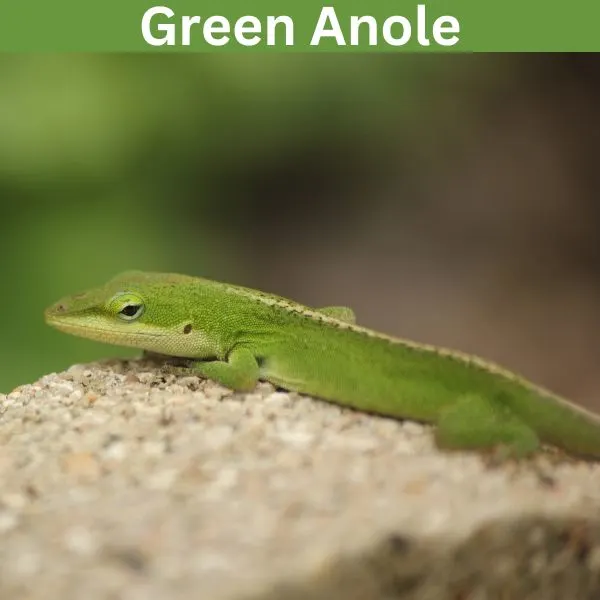
- Experience Level: Beginner
- Family: Dactyloidae
- Scientific Name: Anolis c. carolinensis
- Other Names: American anole, Red-throated anole
- Adult Size: 5 to 8 in. (12.7 to 20.32 cm.)
- Lifespan: 5 to 8 years
- Average Price Range: $10
The northern green anole lizard is a subspecies that lives in the southern half of Tennessee. They are common throughout their range and have a stable population. Green anoles live in high-humidity areas, with lots of trees. They are active during the day, spending their time climbing trees, fences, and shingles. They are common lizards in urban areas.
Medium in size, green anoles are named after their green hue. They can also appear brown, and their color changes depending on their mood, temperature, and environment. Green anoles have a pointed head, with toe pads that help them climb. Males are larger and have a red coloring under their throats.
Male green anoles are territorial and will fight other males that get near them. This lizard feeds on animals like spiders, grasshoppers, beetles, flies, crickets, and other small invertebrates. Larger lizards like the broad-head skink, cats, and birds are what eat this lizard. To help escape they are capable of dropping their tails, which grow back, but shorter.
2. Eastern Fence Lizard
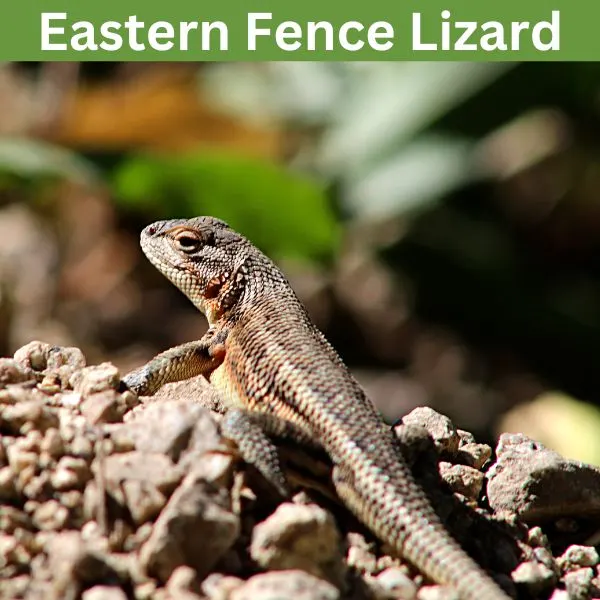
- Experience Level: Intermediate
- Family: Phrynosomatidae
- Scientific Name: Sceloporus undulatus
- Other Names: Prairie lizard, fence swift, pine lizard, gray lizard
- Adult Size: 4 to 7.25 in. (10.16 to 18.41 cm.)
- Lifespan: 4 years
- Average Price Range: $20
Found state-wide across Tennessee, the Eastern fence lizard inhabits various habitats. They are most common in dry and open forests. During the day these lizards bask in the sun on things like trees, rocks, fence posts, and stumps. At night they find crevices to hide in or may even go underground.
The Eastern fence lizard is medium-sized with a robust body. They have gray to brown coloring with keeled scales. Males are smaller and have a uniform color. Female eastern fence lizards may have a dark wavy pattern on their back. Blue or greenish scales appear on the sides of males’ bellies, and under their necks.
These lizards begin to breed in the summer and spring months. The blue patches on males are used to attract mates, and they are aggressive to other males in their territory. Females lay between 1 to 4 eggs, placing them in areas like under logs, or in leaf litter.
Eastern fence lizards are very arboreal, spending their days running up trees. They feed on animals like stink bugs, spiders, moths, ants, and beetles. Snakes, birds, cats, and larger reptiles are the natural predators of this species.
3. Eastern Six-lined Racerunner
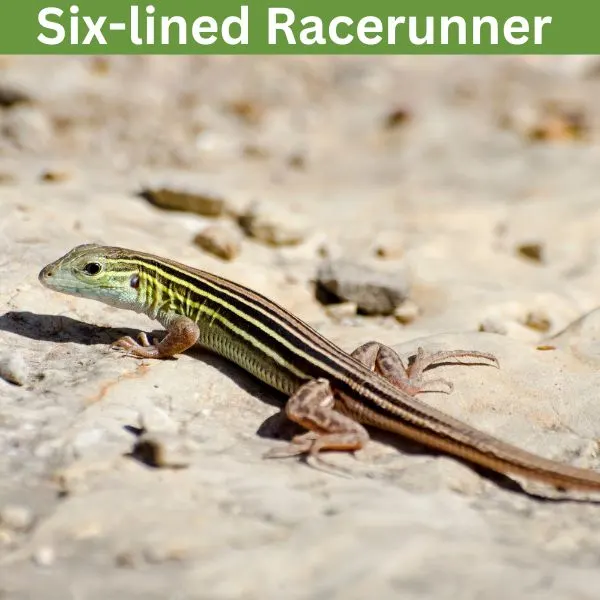
- Experience Level: Intermediate
- Family: Teiidae
- Scientific Name: Aspidoscelis sexlineata sexlineata
- Other Names: Sandlapper lizard
- Adult Size: 6 to 9.5 in. (15 to 24 cm.)
- Lifespan: 4 to 5 years
- Average Price Range: $30
The six-lined racerunner is found across Tennessee, but they are not found in the extreme northwest, northern Cumberland Plateau, upper east of the state, and regions in Highland Rim and Central Basin. The eastern six-lined racerunner is the only subspecies of six-lined racerunner found in the state. They live in habitats like river floodplains, and places with loose, sandy soil.
This species has a dark coloring of green, brown, or black. They have yellow or greenish lines that run down their body. Males have a pale blue underside, while females have a bluish belly. Six-lined race runners have slender bodies, with long tails.
Active during the day, this species spends its time feeding on insects and spiders. They flee if approached, and may bite if handled. Spring and summer are when this lizard mates and they lay around six eggs.
4. Coal Skink
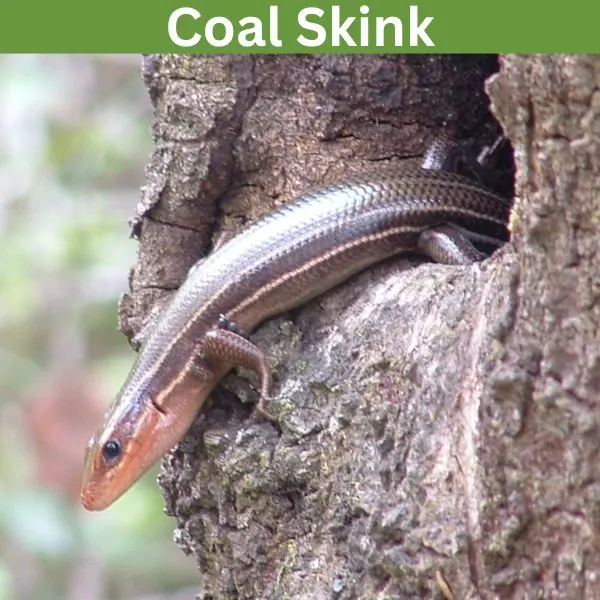
- Experience Level: Intermediate
- Family: Scincidae
- Scientific Name: Plestiodon anthracinus
- Other Names: n/a
- Adult Size: 5.1 to 7.1 in. (13 to 18 cm.)
- Lifespan: 6 years
- Average Price Range: n/a
Coal skinks have a scattered population across the eastern United States and Tennessee. This species lives in forests, next to rivers, and springs. They may also inhibit rocky hillsides. In the state, the most common place to find them is in open forests in west Tennessee, near water. The southern coal skink and northern coal skink are the two subspecies that occur in the state.
Coal skinks have four lines that run down their body. They have olive, greenish, or brown coloring. The belly of this species is gray, and males in the breeding season will have reddish color on their cheeks.
Like other lizards, this species will break off its tail if in danger, so it is best to handle them gently. This lizard is not very common in its range. They feed on small invertebrates and breed in the summer months.
5. Common Five-lined Skink
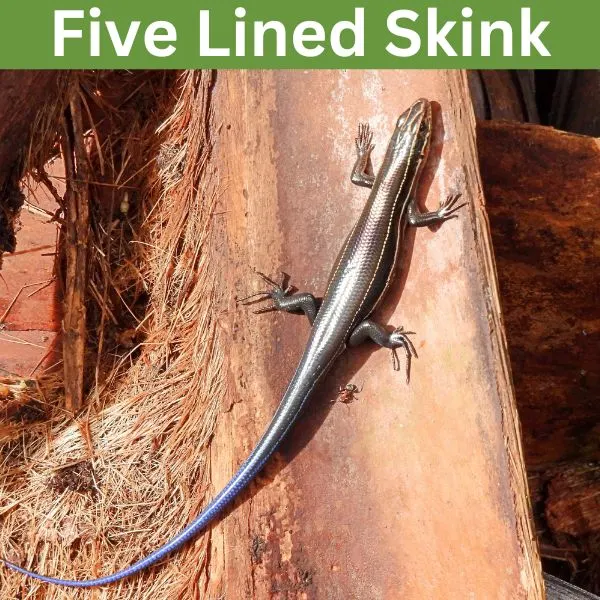
- Experience Level: Intermediate
- Family: Scincidae
- Scientific Name: Plestiodon fasciatus
- Other Names: American
- Adult Size: 4.9 to 8.5 in. (12.5 to 21.5 cm)
- Lifespan: 6 years
- Average Price Range: $12
In Tennessee, the common five-lined skink is found all over the state and is considered the most common lizard species. They prefer moist woodland habitats and hide under debris like rocks, logs, and other debris. Native to North America, this species is mainly found in the eastern United States, but they are also seen In Canada.
When young this lizard has a bright blue tail, and yellow lines running down their body. Common five-lined skinks have black or gray coloring. As they age their blue color fades, and older lizards may lose their stripes.
A terrestrial species, this lizard is active during the day. They prefer moist soil to nest and lay their eggs. In some areas of their overall range, this species has become endangered due to humans since many take them from their habitats. While capable of being kept as a pet, they should never be taken from the wild. They can live up to 10 years with good care and can thrive in a 25 to 30-gallon tank.
6. Southeastern Five-lined Skink
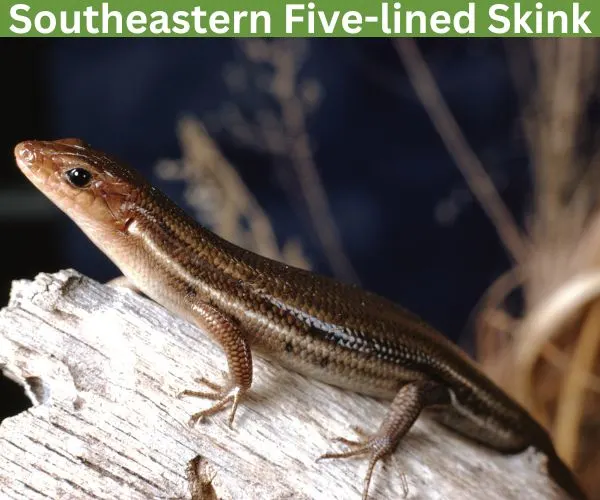
- Experience Level: Beginner
- Family: Scincidae
- Scientific Name: Plestiodon inexpectatus
- Other Names: n/a
- Adult Size: 5.5 to 8.5 in. (13.97 to 21.59 cm.)
- Lifespan: 6 years
- Average Price Range: n/a
In Tennessee, the southeastern five-lined skink is mainly found in the Appalachian Mountains, until the southeast corner of Mississippi. This species lives in wooded habitats, with dry climates. They enjoy climbing on trees, stumps, and large rocks. This lizard’s range mainly covers the southeastern United States.
On their bodies, this lizard has five lines on them, which become less apparent with age. They have broad stripes, with brown or black coloring on them. Males have bronze backs, while females have a more faded color. When young this species has a blue tail and prominent stripes.
Southeastern five-lined skinks are active during the day. They mate in the spring and summer months and lay between six to twelve eggs. Females protect their eggs from predators until they hatch around a month after being laid. Small insects, like grasshoppers, are what this lizard eats.
7. Broad-headed Skink

- Experience Level: Intermediate
- Family: Scincidae
- Scientific Name: Plestiodon laticeps
- Other Names: Broadhead Skink, Red-headed Scorpion
- Adult Size: 5.9 to 13 in. (15 to 33 cm.)
- Lifespan: 4 to 8 years
- Average Price Range: n/a
Native to the southeastern United States, the broad-headed skink lives all over Tennessee. This lizard is absent from the extreme northeastern corner of the state. They are semi-arboreal, living in oak trees. Adults prefer to climb, while juveniles stay closer to the ground.
The broad-headed skink is named after its large jaws, and they have triangular-shaped heads. They have tan or olive coloring, with smooth scales. Males have bright heads that turn red in the mating season. Younger lizards are dark brown, sometimes black, and have stripes, with a blue tail.
A common lizard in Tennessee, this species feeds on small reptiles, rodents, mollusks, and insects. Females when mating do their best to find the largest males and attract them with pheromones. Between 8 to 22 eggs are laid, and they guard them until they hatch in the summer. These species are harmless to humans and are not venomous.
8. Little Brown Skink
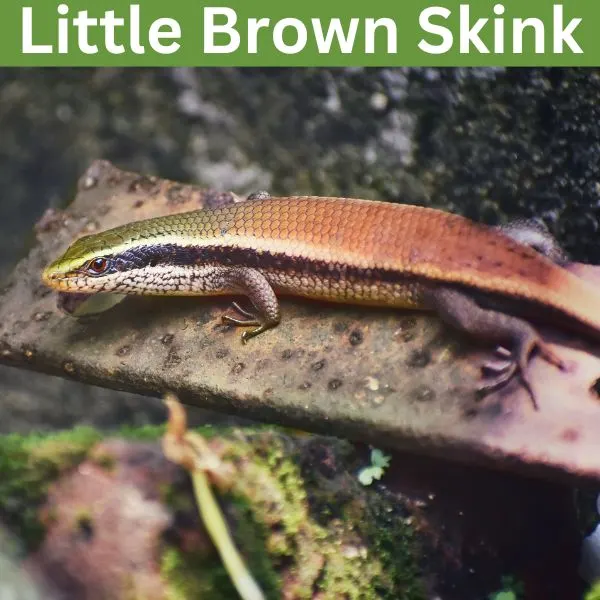
- Experience Level: Beginner
- Family: Scincidae
- Scientific Name: Scincella lateralis
- Other Names: Ground Skink, Brown-backed Skink
- Adult Size: 3 to 5.25 in. (7.62 to 13.3 cm.)
- Lifespan: 2.5 years
- Average Price Range: $5
The little brown skink lives in Tennessee, found all over the state, but its range does not extend to the extreme northeastern corner. This species lives in woodland habitats, spending its time amongst leaf litter, and rotting debris. Little brown skinks are common near streams and ponds. They are fossorial, spending most of their life underground.
This species is very tiny and is one of the smallest lizards in North America. They have coppery coloring, with a white, or yellow underside. Females are larger, but males of this species have larger heads. The little brown skink has a dark coloring on their sides and a black-speckled pattern on their back.
Little brown skinks may be active in the day or night, and in winter they hibernate. They feed on very small insects, spiders, and isopods they find on the ground. They use their tongues and flick them out to sense chemical traces of prey or predators. Their smaller size makes them very susceptible to predators like larger lizards, birds of prey, and snakes.
9. Eastern Slender Glass Lizard

- Experience Level: Intermediate
- Family: Anguidae
- Scientific Name: Thesaurus attenuatus longicaudus
- Other Names: n/a
- Adult Size: 22 to 46 in. (55.88 to 116.84 cm.)
- Lifespan: 10 to 30 years
- Average Price Range: $50
Eastern slender glass lizards are found all across Tennessee but are absent from the northwest, and northeastern regions of the state. The eastern slender glass lizard lives in grasslands, woodlands, and other dry habitats. They are one of the rarest lizards in Tennessee and are considered in need of conservation within the region.
The body of the eastern slender glass lizard is much different than other lizards in Tennessee, and they actually look closer to snakes. They have no legs and have robust, elongated bodies. This species has eyelids unlike snakes, and also has ear openings which snakes lack. They have brown to tan coloring, with white and black longitudinal stripes running down them.
Despite looking like a snake the eastern slender glass lizard is harmless. They have long tails that are capable of detaching if stressed. Terrestrial insects like juvenile rodents and small reptiles are some of the things this lizard eats.
FAQ
What is the largest lizard in Tennessee?
The eastern slender glass lizard is the largest lizard species in Tennessee. The largest of these lizards can reach up to 46 in. Despite having no legs and the body of a snake, this large reptile is actually a lizard.
What are the most common types of lizards in Tennessee?
Skinks are the most common lizard family in Tennessee, and the common five-lined skink is the most abundant species, found statewide. Five of the nine lizard species in Tennessee belong to the Scincidae (skink) family.
Are the lizards in Tennessee dangerous?
None of the lizards in Tennessee are poisonous or venomous, and they are relatively harmless. Most lizards do not bite unless frightened when handled, and if approached you will find them fleeing for a place to hide.
Wrapping up
There are 9 lizards for you to find in Tennessee. Many of them like a few skink species, and anoles make good pets for beginners, but you should never take a lizard from the wild to keep. Wild-caught lizards are more likely to have parasites, or spread other diseases.
Lizards in the wild are also a part of an important ecosystem, as they are used as food by animals like birds, large spiders, and mammals. Lizards also feed on small invertebrates and control the population of multiple pest species. Lizards live in a variety of habitats, and regions across Tennessee.
Other lizards in nearby states
- Lizards in Alabama
- Lizards in Arkansas
- Lizards in Georgia
- Lizards in Kentucky
- Lizards in Mississippi
- Lizards in Missouri
- Lizards in North Carolina
- Lizards in Virginia
